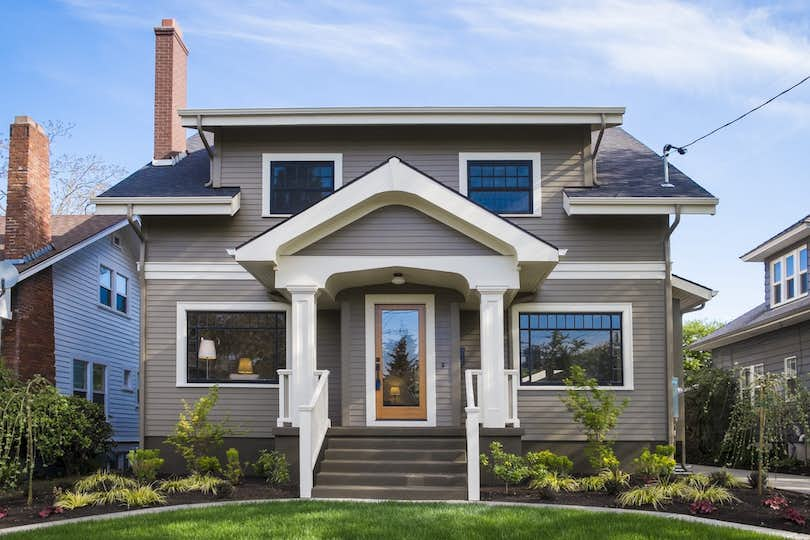Looking to buy a home with character and individuality? A Craftsman-style home may be just what you’re looking for. Keep reading to find out what a Craftsman-style home design is and why it’s experiencing an insane surge in popularity.

Finding a suitable home for yourself and for your family can be a stressful and time-consuming process, especially if you’re on the hunt for something more than a conventional modern-style home. If you’re looking for a home with eye-catching design characteristics and artisan-quality features, it’s hard to look past Craftsman-style properties.
If you want to know whether a Craftsman-style home is the right choice for your living requirements and preferences, we recommend that you get in touch with a top-rated agent in your local area.
In the meantime, we’ve compiled a comprehensive guide to the historic, architectural, and market characteristics of Craftsman-style homes.
What is a Craftsman-style home?
The Craftsman-style home design emerged from an international 19th Century artistic and architectural movement against mass-produced, factory-manufactured housing. Today, even though there are four different types of Craftsman-style homes, each design has remained faithful to three core Craftsman-style values: architectural simplicity, hand-crafted decorative construction, and the use of locally sourced natural materials.
What are the characteristics of a Craftsman-style house?
While it’s always best to consult with a professional architect or real estate agent, we’ve listed descriptions for seven key Craftsman-style house characteristics.
Open Floor Plans
In response to the over-complicated and often cluttered design of pre-fabricated and mass-produced homes, Craftsman-style homes reintroduced the concept of open plan living. To minimize interior walling, most Craftsman-style homes are single story, with each bedroom and bathroom branching off from a central living or family room.
Fireplaces
A home without a central fireplace is generally not considered to be a Craftsman-style home. Craftsman-style fireplaces are usually integrated within the living area and are almost always the centerpiece of the home. Like all Craftsman-style furniture, Craftsman fireplaces pair design simplicity with high-quality, ornate Craftsmanship and detail. Most Craftsman-style fireplaces use native wood and iron paneling to anchor built-in shelving or mantel pieces.
Architectural Style
In many ways, the Craftsman-style home is a return to the architectural flair and attention to detail that characterized home design prior to the industrial revolution. We’ve listed five of the most common architectural features of contemporary Craftsman-style homes:
- A simple covered porch design.
- A general structural emphasis on horizontal lines.
- A central communal living area.
- Deep, column-supported overhanging roof eaves.
- Low-pitched, gabled roofs.
Wide Porches
Wide porches are a staple feature of Craftsman-style homes. The full-width rectangular profile of a Craftsman-style porch not only improves curb appeal, it also provides the homeowner with an inviting area for relaxation or entertainment. Traditional Craftsman-style porches are supported by tapered stone columns and handcrafted wooden railing.
Exposed Beams
As previously discussed, Craftsman-style front porches are typically protected by a single section of deep, low-pitched roofing. To improve durability, Craftsman-style designers almost always reinforce the downward slope of the porch roof with a framework of exposed ceiling and support beams. In true Craftsman style, the exposed beam framework is often used to showcase locally sourced natural materials and hand-crafted rafters or brackets.
Low-Pitched Roofs
Low-pitched roofs are widely regarded as one of the more romantic features of Craftsman-style homes. Reminiscent of Greek or Roman roofing and inspired by classical architectural design, low-pitched roofs on Craftsman-style houses have one-quarter inch of slope per foot and are usually constructed with wide overhanging eaves.
Natural Materials
The use of natural materials and decorative Craftsmanship is a foundational characteristic of the Craftsman-style movement. In contrast to Victorian era opulence, Craftsman-style homes are built with native timber, real brick, genuine stone masonry, and rustic metals, evoking everything from natural symmetry to old-world sturdiness.
The 4 Types of Craftsman-Style Homes
1. Prairie Style
Prairie style homes are a uniquely American variant of the traditional Craftsman-style home design. Prairie homes are so-called because of their suitability for construction on flat plots of land. Most prairie style homes feature low-pitched, hipped, or gable roofs that overhang the perimeter of the home. You can also expect a large open concept floor plan, windows that are set in groups, and a secluded yet ornate front entrance.
2. Mission Style
Reminiscent of Spanish Baroque architecture and authentic mission churches, mission style homes are notable for their distinct roof parapets and, in some cases, ornate bell towers. Originally confined to the California Coastline, mission-style homes have become an increasingly common sight after promotion from a renowned furniture maker named Gustav Stickley pushed the design into national popularity during the early 1900s.
Due to their Spanish design influence, mission style homes often deviate from some of the more traditional aspects of Craftsman-style home design. Rustic materials, smooth stucco finishes, red tile roofs, and open-plan courtyards are the most common features that distinguish mission style homes from traditional Craftsman-style designs.
3. Four-Square Style
Popular from the mid-1890s to the late 1930s, four-square style homes are another common example of American Craftsman architecture. Four-square style homes peaked in popularity after the boom in ornate, Victorian style homes began to subside. In architectural design history, this era is known as the transitional period. During this period, "plainer" and "more honest" dwelling styles experienced a sudden and protracted resurgence in popularity.
A four-square style house can be identified by the signature square shape of the exterior structure and interior rooms. American four-square style homes typically include the following three features: two-and-one-half story construction, pyramidal hip roofs, and a front porch that spans the entire width of the house.
4. Bungalow Style
Originating from the Bengal region of India, bungalow style houses typify the most popular features of the Craftsman-style home design. Besides single-story construction, a bungalow will almost always have a gabled or hipped style low-pitched roof extending over a low-rise balcony or veranda. Overhanging roof eaves on an American bungalow are typically supported by stylish exposed rafters or artisanal decorative brackets.
Looking to purchase a Craftsman-style home?
Get in touch, buy your home, save thousands.
A Brief History of Craftsman-Style Homes
Arts and Crafts Movement
The Arts and Crafts movement was an international cultural movement that sought to combat the industrialization, dandification, and overall impoverishment of Craftsmanship and design in the decorative arts. To reverse these declining standards, the Arts and Crafts movement advocated for the return of traditional materials and artisan Craftsmanship in architecture, furniture making, and decorative design.
After a slow start in Britain, the Arts and Crafts movement began gaining international traction in the early 1900s. By the late 1920s, the Arts and Crafts movement was a flourishing artistic trend in Europe, North America, and parts of East Asia.
In each of these regions, the initial design vision of the Arts and Crafts movement manifested in similar yet unique ways. In North America, the Arts and Crafts movement was predominantly expressed through the surging popularity of Craftsman-style architecture, decoration and furniture.
Gustav Stickley and the Craftsman
Gustav Stickley, an American furniture maker and building designer, was the architect (no pun intended) of the Arts and Crafts movement in America. During the early 1900s, Stickley began using his personal magazine, The Craftsman, to introduce and promote the Arts and Crafts movement in America. Within months, Stickley, who had quickly amassed an enormous audience of devout readers, started using The Craftsman to review and advertize innovative architectural styles and furniture designs.
The popularity of Stickley’s original furniture and house designs encouraged other notable American architects and designers, including Harvey Ellis and Charles Norton, to begin experimenting with the stylistic influence of the Arts and Crafts movement.
Mass Availability
Prior to mass adoption, the Craftsman-style home design was predicated on the idea that a typical American family should be able to live in a beautiful, durable, and practical home without compromising on quality Craftsmanship or serious architectural design. Stickley’s commitment to this idea is the reason Craftsman-style homes remain a popular and accessible living option to this very day.
Considering Buying a Craftsman-Style Home?
If you’re on the fence about purchasing a Craftsman-style home, try taking the time to reflect on the features and architectural styles you look for in a home purchase. To help get you started, we’ve listed three of the most popular Craftsman-style home buyer profiles:
- Because of their open concept interior design, Craftsman-style homes are a popular option for tight-knit families.
- Buyers with an enthusiasm for architecture generally appreciate Craftsman-style homes for their design versatility and cultural significance.
- Due to a recent spike in buyer interest, Craftsman-style homes are also a very attractive option for property investors.
How to Find Craftsman-Style Homes for Sale
Despite a significant uptick in buyer demand, there is still a healthy national supply of Craftsman-style homes for sale. To search for Craftsman-style homes for sale in your city or neighborhood, you can either check an online real estate company MLS or reach out to a local real estate agent.
If you’re looking for more information about the features or market potential of Craftsman-style houses, we recommend that you partner with a full-service real estate agent. A good agent will not only advise you on the local availability and prices of Craftsman-style houses — they’ll support and guide you through the entire purchase process, from house hunting to closing negotiation.
To connect with a top-rated, experienced real estate agent in your local area, get in touch with Clever! When you purchase a home, Craftsman-style or otherwise, through Clever, you’ll have access to full-service agent support, and on-demand property showings.
Top FAQs About Craftsman-Style Homes
Why are they called Craftsman houses?
The term "Craftsman house" is a homage to and derivation of Gustav Stickley’s furniture magazine The Craftsman. As a leading advocate for the British Arts and Crafts movement in America, Stickley, who was frustrated with the rise of mass-produced and factory manufactured furniture and homes, began using his magazine to market and sell handcrafted furniture and Craftsman-style architectural designs to the general public.
What makes a house a Craftsman?
In most cases, a Craftsman-style home will include the following features:
- A covered porch or veranda.
- Tapered set of wide base porch columns.
- Overhanging roof eaves.
- At least two single dormers, often with multiple full-length windows.
- A general architectural emphasis on natural construction materials, particularly stone and timber.
- A large and/or intricate fireplace and mantel.
- A single-story open concept interior layout.
Are Craftsman homes expensive to build?
Yes, the building costs for a Craftsman-style home are significantly more expensive than for a modern-style home.According to HomeAdvisor, the average cost to build a 2,000 square foot, modern-style home is a little over $290,000. In comparison, the average cost to build a similarly sized Craftsman-style home is between $300,000 and $325,000.
What's cheaper: buying or building a home?
In most cases, buying a Craftsman-style home is cheaper than building one. However, this is only a general rule and the average listing price of Craftsman-style houses can vary significantly due to seasonal or day-to-day fluctuations in market supply and local buyer interest.
If you’re trying to calculate the respective costs of building or buying a Craftsman-style home, don’t forget to factor in the recurring living and maintenance costs generally associated with homeownership.



